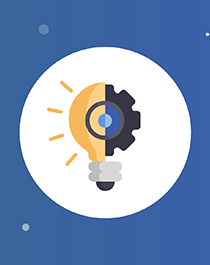How to overcome customer data challenges in Azure Data Lake with a CDP and five strategies for success.
Organizations increasingly aim for a Single Source of Truth (SSOT) with Azure Data Lake. This is understandable, yet it may lead to bottlenecks and challenges. The reason is that creating a complete customer view and making it accessible to employees and applications is more complex than expected.
That’s why they often choose a combination of Data Lake and a Customer Data Platform (CDP). This approach offers flexibility and ensures that the most up-to-date data are always accessible without leaning heavily on scarce IT resources. This is particularly beneficial for departments such as customer care, finance, and marketing.
In this article, we’ll discuss the challenges of moving customer data to Azure and creating a comprehensive customer view. We highlight the possibilities and benefits of a Customer Data Platform, discuss five strategies for working with both software solutions, and share insights to help you effectively use them to achieve significant improvements.
Azure Data Lake is a scalable data storage service available in the Azure Cloud, designed to collect, store, and analyze large amounts of data. It supports storing data in its original format, which means you can apply analyses and machine learning directly to the data without the need to convert or move it first.
Azure Data Lake is often used as a data store, comparable to how FTPS was used in the past, but with increased functionality. It’s frequently linked to a CDP for the exchange of data.
Customer data are often fragmented across diverse systems and sources. They need to be merged and structured to get a complete customer view. However, specialist knowledge is required for collecting, modifying, and loading these data.
Due to the different formats and structures, combining data from various sources and systems is complex. Even though Azure provides tools such as Azure Data Factory, tight planning and execution remain crucial. However, finding specialists for long-term management and maintenance is difficult.
Organizations with large amounts of customer data struggle with scalability. This data requires modern processing, analysis, and storage infrastructure, which leads to rapidly rising storage costs.
The collection and processing of customer data must comply with privacy and regulations, including creating a customer view. However, data in Azure can be fragmented, making adhering to these rules complex. That’s why centralized management and control over these data streams are essential.
Analytic tools and skills are necessary to gain valuable insights from customer data. For this purpose, Azure offers diverse services, such as Azure Synapse Analytics and Azure Machine Learning. Yet, you need to know how they work to use them appropriately.

Thanks to a CDP's possibilities, this platform technology marks the perfect addition to Azure Data Lake. A CDP centralizes, structures, and manages all customer data, enabling you to create a complete 360-degree customer view.

With a Customer Data Platform (CDP), you use your customer data to its maximum potential. We give you 8 reasons why a CDP is essential for understanding, reaching, and serving customers.
A solid plan is paramount for working with Azure Data Lake and a CDP. Start small and expand gradually with a phased approach. It’s also wise to consult expertise outside your organization and look for partners with experience in Azure Data Lake and CDP implementations.
There are multiple helpful strategies to apply both solutions effectively :

Creating a customer view in Azure can be complex due to integrating data sources, processing large amounts of data, privacy limitations, and the necessary expertise. Fortunately, with the correct planning, tools, and expertise, organizations can shape a solid customer view to gain valuable insights and offer personalized experiences.
It’s important to consider what data you store in Azure Data Lake and which processes and tasks you execute via Azure. Maybe there are alternatives available for this. Specifically, a Customer Data Platform (CDP) is a powerful solution for the challenges that come with Azure. A CDP centralizes customer data, simplifies management, and makes it possible to integrate data seamlessly with other systems. Features such as advanced data analysis, direct data linking for marketing campaigns, and user-friendly dashboards make a CDP a fundamental solution for a customer-centric organization.

Learn how our Customer Data Platform bundles all your customer data into one unique customer view. In our no-code platform, you set the rules and learn to manage customer data, with our advice at your disposal when needed.
Contact us today to learn how we can help you optimally apply and use your customer data.
A Customer Data Platform (CDP) collects, integrates, and analyzes customer data from multiple sources, creating a comprehensive 360-degree view of your customers. This enables you to gain deeper insights and enhance their experience, ultimately maximizing your return on investment.
Contact us for a brief introductory discussion on how to harness the power of your customer data. No obligations, just valuable insights!
Unlock the potential of your customer data with our customer value guide! Discover a practical four-step plan to enhance your services and boost customer loyalty.
Leave your details to download your free customer value guide now!
With our data platform technology we are going above and beyond: you organize thousands of (marketing) actions, create analyses, complete missing information and control and monitor all customer data. And these are merely examples.
Discover how we make your organization data-driven and what you achieve with the unique customer view. Tell us more about yourself and we'll contact you soon.
The Invenna platforms are suited for small and large companies. For marketing, analytics, compliance and IT. And for diverse industries such as autmotive and charity.
Because of the numerous options and organization's individual needs and wishes, we'd like to show you what you can do and achieve with our platforms. Leave your details and we'll contact you to schedule a (digital) demo. Free and without strings attached.
In the brochure you read what the Invenna Customer Data Platform offers you and the benefits of working with a unique customer view. And to get you started, we also share a few use cases.
Leave your details and we'll send you the brochure via email.
Whether you’re looking to improve your operational processes or gain a quicker response to marketing and sales activities: the Customer Data Platform helps to achieve goals.
Get in touch with us and we’ll tell you more about merging all your customer data into a unique customer view. And equally important: what you achieve with the platform.
In the brochure you read what the Invenna Customer Data Platform offers you and the benefits of working with a unique customer view. And to get you started, we also share a few use cases.
Leave your details and we'll send you the brochure via email.
The possibilities of the Invenna Customer Data Platform B2C are limitless. Because of organization's individual needs and wishes, we'd like to show you our platform and its features so you get an idea of how it helps to achieve your goals.
Leave your details and we'll contact you to schedule a (digital) demo. Free and without strings attached.
In the brochure you read what the Invenna Customer Data Platform offers you and the benefits of working with a unique customer view. And to get you started, we also share a few use cases.
Leave your details and we'll send you the brochure via email.
Whether you’re looking to improve your operational processes or gain a quicker response to marketing and sales activities: the Customer Data Platform for B2B helps to achieve goals.
Get in touch with us and we’ll tell you more about merging all your customer data into the unique customer view and how you can benefit from the platform.
In the brochure you read what the Invenna Customer Data Platform offers you and the benefits of working with a unique customer view. And to get you started, we also share a few use cases.
Leave your details and we'll send you the brochure via email.
The possibilities of the Invenna Customer Data Platform B2B are limitless. Because of organization's individual needs and wishes, we'd like to show you our platform and its features so you get an idea of how it helps to achieve your goals.
Leave your details and we'll contact you to schedule a (digital) demo. Free and without strings attached.
In the brochure you read what the Invenna KYC platform offers you and the benefits of working with a unique and complete customer view. And for inspiration, we also share extra content.
Leave your details and we'll send you the brochure via email.
Whether you’re looking to improve your operational processes or respond more swiftly to potential risks: the KYC platform helps to achieve goals.
Get in touch with us and we’ll tell you more about merging all your customer and transaction data into the unique customer view.
The possibilities of the Invenna KYC platform are limitless. Because of organization's individual needs and wishes, we'd like to show you our platform and its features so you get an idea of how it helps to achieve your goals.
Leave your details and we'll contact you to schedule a (digital) demo. Free and without strings attached.
In the brochure you read what the Invenna KYC platform offers you and the benefits of working with a unique and complete customer view. And for inspiration, we also share extra content.
Leave your details and we'll send you the brochure via email.
We work with and for over 75 of The Netherlands’s finest brands every day. From Mediahuis and Nissan to the Tax and Customs Administration and Dutch police. So we've grown considerably, but still don't shy away from any customer data challenge.
Would you like to know more about is? Or are you wondering how we make your organization more data-driven? Tell us more about yourself and we'll contact you soon.